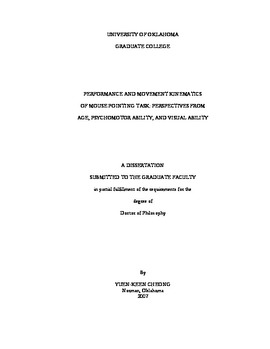| dc.contributor.advisor | Shehab, Randa L., | en_US |
| dc.contributor.advisor | Ling, Chen, | en_US |
| dc.contributor.author | Cheong, Yuen-keen. | en_US |
| dc.date.accessioned | 2013-08-16T12:20:54Z | |
| dc.date.available | 2013-08-16T12:20:54Z | |
| dc.date.issued | 2007 | en_US |
| dc.identifier.uri | https://hdl.handle.net/11244/1255 | |
| dc.description.abstract | Results from the first study confirmed the suspicion that not all kinematic measures reported in the literature were related to performance. For instance, although peak velocity is the most reported measure in the literature, it does not have any effect on performance. Kinematic measures correlate with performance are mainly temporal in nature, such as time to peak velocity, time to peak acceleration, and time from peak velocity until the end of movement. In the second study, as expected, age effects were detected in various kinematic measures. However, further investigation revealed the differences could in fact be attributed to psychomotor ability, but not the age effect per se. In general, the results confirm the notion of age being a surrogate variable, and that the causal relationship is in fact more directly related to age-related changes in psychomotor ability. In the third study, kinematics of the initial submovement for the low vision and the normal vision groups are stereotypical. However, the homing phase was significantly different between the two groups. | en_US |
| dc.description.abstract | This dissertation research consists of three related studies evolving around the movement kinematics of mouse-mediated pointing task. Movement time and error rates are the common performance measures used in similar studies. However, the performance-oriented approach is not capable of providing information about what happens "during" the movement. It is believed that much can be learned from studying the movement process. Investigation of movement process is often done by studying its kinematics, by which can be characterized using various measures. However, despite the common belief, it is suspected that certain kinematic measures do not have any relationship with movement performance. Therefore, the first study was conducted to determine the kinematics-performance relationship of a mouse pointing task. | en_US |
| dc.description.abstract | Of greater interest are the effects of age and functional abilities on the kinematics of aiming movement. The age effect is often identified as the cause of reduced performance. However, some argue the direct cause of such a reduction is actually due to age-related changes in functional abilities such as psychomotor ability. Based on that notion, it is hypothesized that the age effect on mouse use will become negligible if the effect of psychomotor ability is considered in parallel. Thus, the second study investigated the effects of age on mouse use, including after the psychomotor ability is included. Since good eye-hand coordination is required for mouse use, the research will be incomplete without considering how varying degree of visual ability can affect movement kinematics. Following along that line, the third study determined kinematic differences between people with low vision and those with normal vision. | en_US |
| dc.format.extent | xi, 136 leaves : | en_US |
| dc.subject | Engineering, Industrial. | en_US |
| dc.subject | Human-computer interaction. | en_US |
| dc.subject | Mice (Computers) | en_US |
| dc.subject | Kinematics. | en_US |
| dc.title | Performance and movement kinematics of mouse pointing task: Perspectives from age, psychomotor ability, and visual ability. | en_US |
| dc.type | Thesis | en_US |
| dc.thesis.degree | Ph.D. | en_US |
| dc.thesis.degreeDiscipline | School of Industrial and Systems Engineering | en_US |
| dc.note | Advisers: Randa L. Shehab; Chen Ling. | en_US |
| dc.note | Source: Dissertation Abstracts International, Volume: 68-10, Section: B, page: 6887. | en_US |
| ou.identifier | (UMI)AAI3283841 | en_US |
| ou.group | College of Engineering::School of Industrial and Systems Engineering | |
